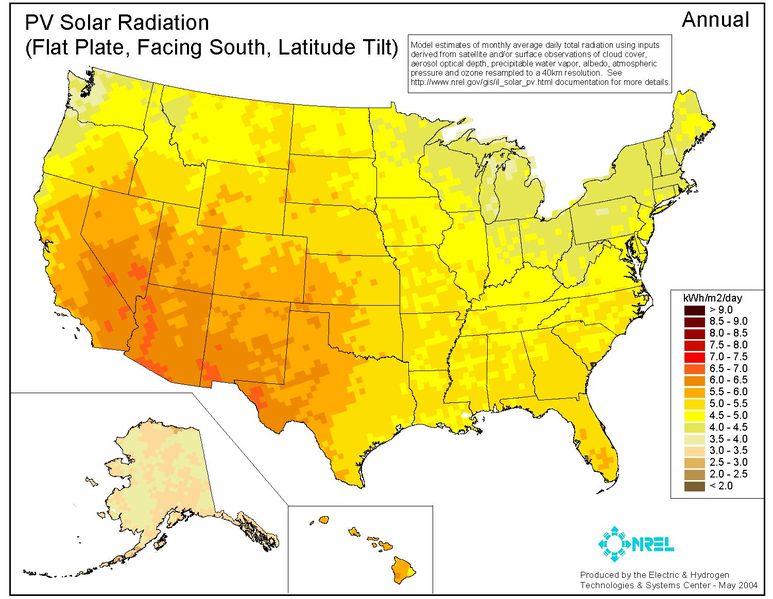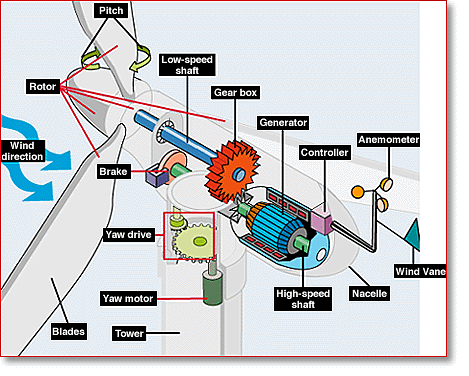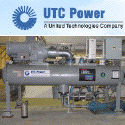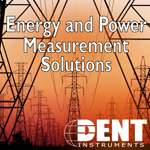Blog Archives
Community portable power bag (and lights)
If you’re into way off the grid living, this is an interesting way to get some light. The University of Michigan has done some prototyping on a “light bag” – effectively a solar textile that charges 6 individual lamps and/or a central battery.

Technorati Tags: Solar | Light | Energy
Let the sunshine in
You might recall “Aquarius/Let the Sunshine In” as a catchy little tune from the musical Hair, but that’s not what this entry is about…
It turns out that the energy in sunlight is measured at 250 watts/square meter on average across the US, or 3 KWh/square meter/day. See the NREL map below for details.

Now don’t go out and buy solar panels for your roof just yet, not all of that available energy can be directly translated into electricity, the best solar panels are about 15% efficient which means that one might harvest as much as 0.45 KWh/square meter/day into direct current, during day time. Obviously the amount of energy produced is related to location, hours of direct/indirect sunlight, and weather. So just what are these solar panels (photovoltaic cells) anyway?
Photovoltaic (PV) cells are a semi-conductor that absorbs sunlight (photons) into charge carriers (electrons) then directs them to a conductor. Typically, PV cells are grouped into arrays and placed on sheets or panels which in turn are arrayed to generate a desired amount of electricity. Solar panels have been in use for years in space applications, remote sensors, pocket calculators, and increasingly, for individual home power generation (or co-generation.)
There have been some efforts to get to utility scale with PV technology, but the cost remains prohibitive (~$0.20/KWh competing against $0.03-0.07/KWh for other technologies.) Japan and Germany have the most installed PV technology with the largest single installation rated at 12 MW peak production. To put this in perspective, the average fossil fuel plant in the US is rated at 219 MW peak production and the average nuclear plant in the US at 2,000 MW. As costs for PV continue to drop (as they have around 3% per year over the past few years) coupled with fossil fuel cost increases, the point at which PV becomes profitable at scale will likely happen in the next 15 years.
PV power generation does have some distinct advantages including $0 fuel costs, zero-emission power generation, long equipment lifespan, relatively low maintenance costs, and modular application scaling from micro-installations up to small utility size. The disadvantages to solar are in capacity factor, it’s only light so many hours per day and power demands are 24/7. Relatively speaking, it’s expensive to procure and install. And finally, the resulting power is direct current which further degrades efficiency as the power must be “inverted” to use on the grid or in typical AC household power systems. I’ve heard there may be some breakthrough research happening on the production of PV cells that radically change the costs of PV; if this happens, solar may become mainstream faster than any of us would expect.
Google is certainly making a go of it. Recently, the company announced a plan to install solar panels on its buildings (1.6 MW) and that the resulting power would satisfy up to 30% of the company’s energy requirement. Aside from being good for the planet, I presume someone ran the numbers to see this would at least be a slightly positive return on investment.
Technorati Tags: Energy | Solar | Photovoltaic
A mighty wind
And I’m not talking about the movie of the same title… Do you know how much a cubic meter of dry air weighs at sealevel?
About 1kg (1.0007 kg to be exact.) Air also has pressure, at sea level, about 10,194 kg/square meter (14.5 lbs/square inch.) Air also moves, you might have noticed this phenomena called wind. As the Sun heats the atmosphere air will naturally flow (convection) moving from high pressure areas to low pressure areas – it’s effectively a way for the atmosphere to move heat around.
So we’ve got mass and we’ve got movement which means that there must be a way to harness this excess energy flowing around the planet. For many thousands of years humans have used sails to capture the wind and for hundreds of years, sails anchored in place attached to a shaft converting wind energy to mechanical energy. This energy was used in the past to pump water, saw wood, grind things, etc. Today, high efficiency wind turbines are available and being installed for the purpose of converting wind energy into electricity.
Utility scale wind turbines

Each wind turbine has a shaft connected to a gearbox that drives an electrical generator. The turbines also have brakes, yaw and pitch controls, weather stations, and power transmission capability built into them (see diagram below.) Each turbine in a wind farm transmits its power to a shared substation where the electricity is stepped up to the right voltage to enter a supply line for the electricity grid.

The electric production capacity harvested from wind energy has grown from 2.8 gigawatt hours (GWh) in 1992 to 18.8 GWh in 2006 (trailing twelve month calculation.) Wind farms are now sprouting up in many different states across the US with Texas now leading wind production closely followed by California.
Major advantages to wind generated electricity start with fuel cost, $0. Wind farms are also very low impact on the environment in terms of emitted pollution into the atmosphere, ground, and water. In addition, wind farms literally provide another crop for farmers as the actual land usage tends to be small (less than 200 sq meters) for each turbine allowing agriculture to continue even as wind is harvested. Wind farms are also relatively easy to construct and put into service taking an average of 18 months to complete.
The major disadvantages to wind power are predictability of supply, one cannot guarantee that wind will blow when demand for power exists. Also, aesthetics, many people do not like to see ridges peppered with large steel towers with rotating props. And finally, avian impacts. In some wind installations, the death rate for birds, particularly raptors is elevated due to collisions with the props and towers. Each of these issues has solutions and with each new installation, the objections decrease.
Even taking into account the disadvantages, wind still is a vital part of the renewable energy portfolio and continues to grow at a fast pace.
Technorati Tags: Energy | Wind | Turbine
What is renewable energy?
That’s a question I’ve gotten routinely. Here’s the “official” definition from the US Government used to purchase renewable energy:
Executive Order 13323: Renewable energy is energy produced from biomass, geothermal, solar, and wind sources.
Practically speaking, renewable energy is energy whose source is not destroyed when harnessed. The principal renewable energy sources in use today are:
- Hydro: Harnesses water action (gravity, tides, etc.)
- Solar Thermal: Harnesses the Sun’s heat
- Solar Photovoltaic: Harnesses the Sun’s photons
- Wind: Harnesses wind currents
- Geothermal: Harnesses the heat of the Earth
- Biomass: Harnesses photosynthesis process
Each of these sources has a number of different technologies associated with their capture and translation to energy in our society. For instance, in the wind case, wind energy is translated to mechanical energy by physically turning a shaft. That shaft in turn is connected to a generator which translates the mechanical energy into electrical energy. Wind energy has one huge advantage over say, natural gas fired electricity generation: Wind is free. That economic benefit can’t help but assert itself as fossil fuels become more scarce and more expensive.
Besides not destroying the source of the energy, renewable energy sources often have other benefits like low levels pollutants emitted into the atmosphere. Renewable energy is also termed sustainable because of its unique properties. The renewable energy sources exist, the technologies to harness these sources exist, therefore there is little reason not to pursue renewable energy both for electricity generation and for transportation.
Technorati Tags: Renewable | Energy | Sources
What is the best homeland security?
Energy independence.
It’s that simple. Every $ sent to foreign entities (and perhaps some domestic entities with international interests) provides a small bit of leverage in the way we project ourselves as a nation on the globe. As George Washington stated in 1796, “Nations have interests, not friends.” Those $ sent offshore do little to advance our interests; often these $ fund activities diametrically opposed to our interests. Where did Osama bin Laden’s money come from? In part, your energy $.
The technology exists today to harness renewable energy of all types to generate electricity and for use in transportation. These are no longer wacky hippie projects, these are serious commercial enterprises intended to make a profit. And profit they will when we as a nation wake up and assert our will to keep our energy $ at home and become as independent as possible.
How? you might ask. Fair enough, by making choices. Instead of investing to build a new 250MW Gas-fired electricity generation facility, choose to install a 250MW wind farm. Instead of having a useless “middle grade” gasoline, offer E85. Instead of spending billions and billions on failed programs (i.e., Department of Homeland Security) redirect that funding to create more efficient renewable energy technologies. We must only find the will to make the change in our thinking, our decisions, and our priorities.
Technorati Tags: Energy | Policy | Security








